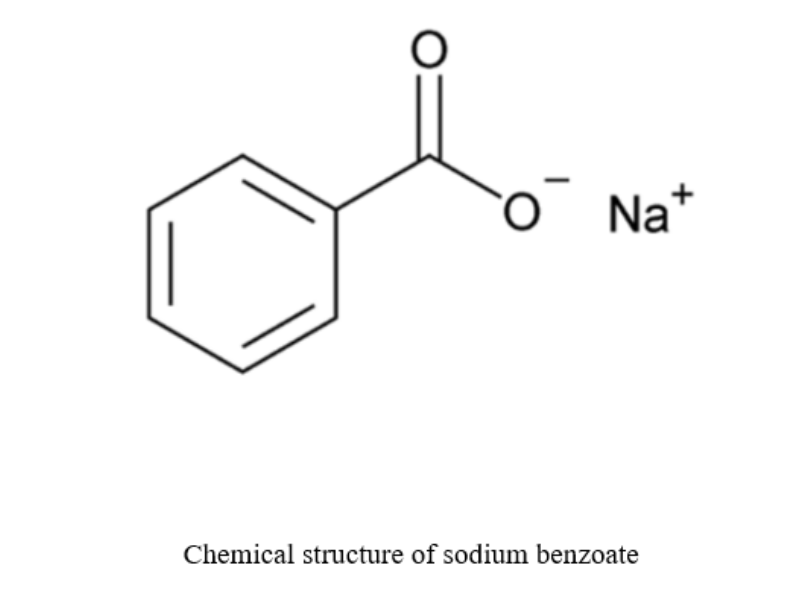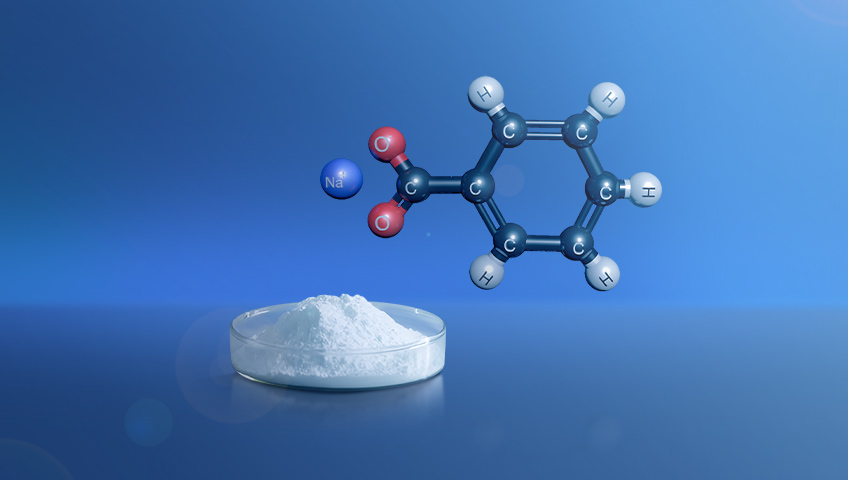2025.12.09
Sodium benzoate
Sodium benzoate (E211), with the chemical formula NaC7H5O2, is an odorless food additive that dissolves well in water. It is widely used in the food industry as a preservative (for long shelf life) due to its antifungal and antibacterial properties. Sodium benzoate is commonly used in acidic environments with a pH of less than 4, because in these conditions, it transforms into benzoic acid (a microbiological agent) which has stronger antimicrobial and preservative properties.

Foods containing sodium benzoate
Sodium benzoate is used in a wide range of food products, including factory-made jams and jellies, industrial pickles and cucumbers, margarine (vegetable butter), canned olives, fruit-flavored yogurts, canned vegetables, carbonated drinks, various sauces, canned fruits, packaged fruit juices, packaged cakes, and more. The most common use of sodium benzoate in the food industry as a preservative is in carbonated soft drinks and packaged fruit juices.
Dangers of sodium benzoate
Sodium benzoate, while extending the shelf life of food products, beverages, and etc., is also recognized as a potential threat to human health. The most significant health effects associated with the consumption of foods containing sodium benzoate include:
- Long-term and continuous consumption of foods containing sodium benzoate may harm the liver. The liver is one of the main organs for metabolizing chemicals (such as drugs and toxins). Sodium benzoate may interfere with this process, leading to symptoms such as inflammation, liver cell damage, and liver dysfunction.
- When a person consumes food containing sodium benzoate, the substance may trigger immune system irritation and allergic reactions, such as skin rashes. These irritations occur due to the release of natural chemicals (like histamine) in the body, leading to inflammation and skin reactions such as itching, redness, and swelling. In some individuals with a sensitive immune system, more severe reactions like asthma (chronic lung disease that causes inflammation and narrowing of the airways in the lungs) may also occur.
- Evidence suggests that sodium benzoate can act as a trigger for attention deficit disorder (such as distractibility) and hyperactive behaviors in children who consume beverages containing sodium benzoate preservatives. These symptoms may be due to the impact of sodium benzoate on the nervous system, causing dysfunction that leads to hyperactive behavior and decreased concentration.
- Sodium benzoate may damage DNA (the genetic material). This damage can result from the direct interaction of sodium benzoate with DNA molecules, causing genetic mutations that lead to irreversible changes in cells. These changes may ultimately increase the risk of genetic disorders and cancer.
- Research on animals suggests that sodium benzoate may have widespread negative effects on health, including intestinal bleeding, disruption of gut microbiota balance (the microorganisms that naturally live in the intestines), hormonal disorders, reduced fertility, kidney damage, increased cholesterol levels, high blood pressure, reduced fetal growth, decreased white blood cell count, and other problems. These findings have primarily been based on studies conducted on mice and other laboratory animals, and in many cases, the results have been confirmed. Although human research on this subject is not yet sufficiently comprehensive, the physiological similarities between humans and lab animals such as mice suggest that similar health issues may occur in humans as well.
- When sodium benzoate and ascorbic acid (Vitamin C) or similar acids like citric acid are present together in food, a chemical reaction can occur between these compounds. Ascorbic acid can break down sodium benzoate, leading to the production of benzene. However, this reaction typically occurs under specific conditions, such as high temperatures (around 45°C) and prolonged exposure to intense ultraviolet (UV) radiation (e.g., more than 20 hours). These conditions can increase the breakdown rate of sodium benzoate and the formation of benzene. However, at normal human body temperature (around 37°C) and under regular conditions, such a reaction does not spontaneously occur. The body’s metabolic and enzymatic systems effectively prevent undesirable chemical reactions like benzene formation. Benzene has been classified as a carcinogen by the International Agency for Research on Cancer (IARC), and prolonged exposure to it increases the risk of various cancers, particularly blood cancer. The database (Food Scores) belongs to the Environmental Working Group (EWG) in the United States, revealed that more than 20,000 products simultaneously contain compounds like sodium benzoate, citric acid, or ascorbic acid. This database lists products based on concerns regarding their ingredients, nutritional value, and production process. Some carbonated soft drinks and certain sauces (like some mayonnaise varieties) are examples of foods that likely contain both sodium benzoate and citric or ascorbic acid. Therefore, the storage and transport conditions of such products before reaching your store or home can have significant impacts on their quality and safety, especially when exposed to direct sunlight and temperatures above 45°C. Many carbonated soft drinks and similar products may be exposed to outdoor storage and direct sunlight for hours or even days during warehousing and transport. These conditions can significantly raise the temperature of the contents of the bottles, which can lead to a chemical reaction between sodium benzoate and ascorbic acid, resulting in benzene formation.
Conclusion
Given the importance of public health and the concerns raised by studies on sodium benzoate consumption, it is essential to make informed choices when selecting food products. Paying attention to ingredient lists, prioritizing fresh and natural foods and following proper food storage practices are among the key measures that can help reduce the potential adverse effects of sodium benzoate.


